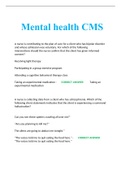Samenvatting
Samenvatting artikelen
- Instelling
- Universiteit Leiden (UL)
Een samenvatting van alle verplichte artikelen voor het vak 'Kindermishandeling en verwaarlozing over de levensloop; een introductie' bij Universiteit Leiden. Ik heb ook een samenvatting van de boeken voor dit van (Miller-Perrin en De Kleine gids kindermishandeling). Deze zijn apart te koop.
[Meer zien]













